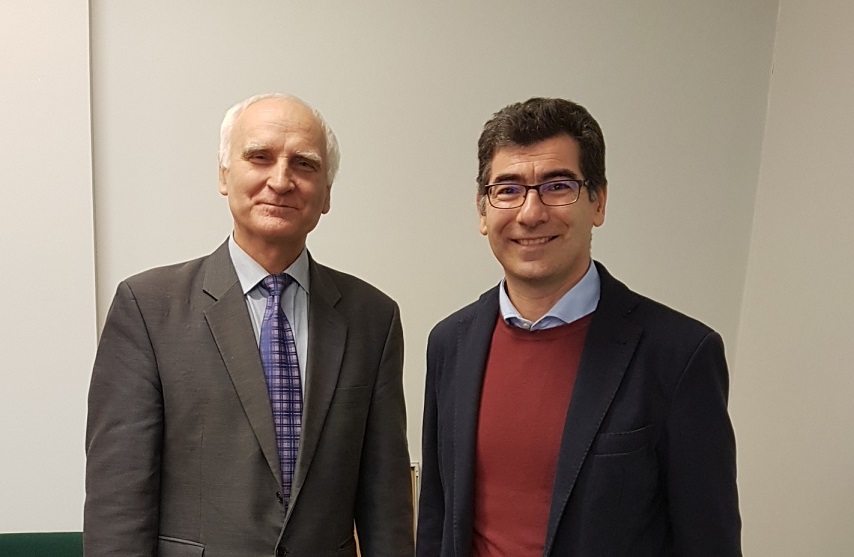ISKO Italia. Documenti
Teacher
 prof. Carlo Bianchini
prof. Carlo Bianchini
(University of Pavia, Department of Musicology and Cultural Heritage)
Program
Wednesday, January 16
lecture
Introduction to bibliographic classifications
Start: 8.00. End: 9.30
room 2.122/123 (help: prof. Babik, contact: room 3.301)
lecture, scientific meeting
From the semantic web to faceted class number: a case study on data.bnf.fr and CC
Start: 13.45. End: 14.30
room 3.228 (help: prof. Sapa, contact: room 3.209)
Thursday, January 17
A laboratory about the comparison between enumerative and analytical classification (exemplified by Dewey Decimal Classification and Colon Classification)
The laboratory will be repeated three times for three different groups of people
Group 1 laboratory
Start: 8.00. End: 9.30
room 3.120 (help: mgr M. Deja)
Group 2 laboratory
Start: 9.45. End: 11.15
room 3.120 (help: dr P. Korycinska-Huras)
Group 3 laboratory
Start: 11.30. End: 13.00
room 3.120 (help: dr M. Wójcik)
Introduction
Dewey Decimal Classification is well known and widespread all over the world. Created by Melvil
Dewey (1851-1931), it is the most diffused classification in the world, used in more than 130
countries and in more than 60 national bibliographies. A large part of its success is due to the use
of the decimal notation, that is a hospitable notation, able to host continuous progresses and changes
in knowledge, and to manage relative location (Gnoli 2018), facing
more and more pressing issues in American libraries at the end of the XIX Century.
Colon Classification was the first fully analytico-synthetic classification scheme, created in 1993 by
S.R. Ranganathan in order to overcome the limits of the hierarchical-enumerative classification
schemes in the precise representation of subjects of more and more specialized documents
published at the beginning of the XX Century.
Even if not largely used, its interest is not just historical, as its design makes it a useful tools
nowadays too. Two examples of this are its potential use in shelf organization of
resources in small libraries, where it is difficult to assure man power to create a modern online
catalogue (one-person libraries), and its effectiveness and worth in training subject cataloguing
librarians, as conceptual analysis required by Colon Classification stimulates and facilitates the
conceptual analysis required by any subject indexing language. For example, the deep roots of
Nuovo Soggettario (an Italian general thesaurus) in Ranganathan's studies facilitate the
simultaneous use of Nuovo Soggettario and Colon Classification.
Finally, the creation of full CC call numbers allows the organization of resources on the shelves in a
"filiatory sequence", that is the most useful linear sequence for the final user, compliant to FRBR
and capable of grouping resources per Works, Expressions, Manifestations, and Items.
Goals
 The seminar aims to present and compare the main characteristics of Dewey Decimal Classification,
23rd edition, and Colon Classification, 6th edition. It also aims to highlight benefits connected to the
use of facets within the classification process. Finally, it has the objective to give participants the
basics to start using both systems and to appreciate the advantages of using Colon Classification for a book collection (in whole or in part).
The seminar aims to present and compare the main characteristics of Dewey Decimal Classification,
23rd edition, and Colon Classification, 6th edition. It also aims to highlight benefits connected to the
use of facets within the classification process. Finally, it has the objective to give participants the
basics to start using both systems and to appreciate the advantages of using Colon Classification for a book collection (in whole or in part).
Teaching approach
The seminar will be held in the first part as a direct lecture, and in the second part (repeated three times in the second day) by means of teacher guided instructional tasks for students.
Learning objectives
Upon completion of this course, students will be able to:
- State the distinguishing characteristics of enumerative and analytico-synthetic classification schemes;
- Select the most appropriate classification scheme for a specific context of use;
- Identify concepts in simple subjects;
- Use simplified tables of classifications;
- Select the main classes and subclasses in both classification schemes;
- Use the classification schemes to classify subjects;
- Combine simple notations in faceted call numbers.
Prerequisites
Basic knowledge of English language.
Contents
- Introduction to bibliographic classifications
- Main characteristics of Dewey Decimal Classification
- Main characteristics of Colon Classification
- Classification process (in both systems)
- Creation of CC class number from LOD

Educational material
Information and contacts
remigiusz.sapa@uj.edu.pl
carlo.bianchini@unipv.it
Bibliographic classifications: Dewey, Colon and linked data = (ISKO Italia. Documenti) —
<http://www.iskoi.org/doc/krakow.htm> : 2018.12.13 - 2019.01.31 -



 The seminar aims to present and compare the main characteristics of Dewey Decimal Classification,
23rd edition, and Colon Classification, 6th edition. It also aims to highlight benefits connected to the
use of facets within the classification process. Finally, it has the objective to give participants the
basics to start using both systems and to appreciate the advantages of using Colon Classification for a book collection (in whole or in part).
The seminar aims to present and compare the main characteristics of Dewey Decimal Classification,
23rd edition, and Colon Classification, 6th edition. It also aims to highlight benefits connected to the
use of facets within the classification process. Finally, it has the objective to give participants the
basics to start using both systems and to appreciate the advantages of using Colon Classification for a book collection (in whole or in part).